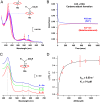A de novo peroxidase is also a promiscuous yet stereoselective carbene transferase
- PMID: 31896585
- PMCID: PMC6983366
- DOI: 10.1073/pnas.1915054117
A de novo peroxidase is also a promiscuous yet stereoselective carbene transferase
Abstract
By constructing an in vivo-assembled, catalytically proficient peroxidase, C45, we have recently demonstrated the catalytic potential of simple, de novo-designed heme proteins. Here, we show that C45's enzymatic activity extends to the efficient and stereoselective intermolecular transfer of carbenes to olefins, heterocycles, aldehydes, and amines. Not only is this a report of carbene transferase activity in a completely de novo protein, but also of enzyme-catalyzed ring expansion of aromatic heterocycles via carbene transfer by any enzyme.
Keywords: biocatalysis; biocatalytic ring expansion; carbene transfer; de novo protein design; enzyme design.
Copyright © 2020 the Author(s). Published by PNAS.
Conflict of interest statement
The authors declare no competing interest.
Figures





Similar articles
-
Chemoselective N-H insertion catalyzed by a de novo carbene transferase.Biotechnol Appl Biochem. 2020 Jul;67(4):527-535. doi: 10.1002/bab.1924. Epub 2020 May 22. Biotechnol Appl Biochem. 2020. PMID: 32277840
-
Substrate promiscuity of a de novo designed peroxidase.J Inorg Biochem. 2021 Apr;217:111370. doi: 10.1016/j.jinorgbio.2021.111370. Epub 2021 Feb 12. J Inorg Biochem. 2021. PMID: 33621939
-
YhjA - An Escherichia coli trihemic enzyme with quinol peroxidase activity.Biochim Biophys Acta Bioenerg. 2018 Jun;1859(6):411-422. doi: 10.1016/j.bbabio.2018.03.008. Epub 2018 Mar 14. Biochim Biophys Acta Bioenerg. 2018. PMID: 29550214
-
Navigating the Unnatural Reaction Space: Directed Evolution of Heme Proteins for Selective Carbene and Nitrene Transfer.Acc Chem Res. 2021 Mar 2;54(5):1209-1225. doi: 10.1021/acs.accounts.0c00591. Epub 2021 Jan 25. Acc Chem Res. 2021. PMID: 33491448 Free PMC article. Review.
-
Organocatalysis Combined with Photocatalysis.Top Curr Chem (Cham). 2019 Nov 15;377(6):37. doi: 10.1007/s41061-019-0265-0. Top Curr Chem (Cham). 2019. PMID: 31728771 Review.
Cited by
-
Recent Progress Using De Novo Design to Study Protein Structure, Design and Binding Interactions.Life (Basel). 2021 Mar 10;11(3):225. doi: 10.3390/life11030225. Life (Basel). 2021. PMID: 33802210 Free PMC article. Review.
-
Use of an Artificial Miniaturized Enzyme in Hydrogen Peroxide Detection by Chemiluminescence.Sensors (Basel). 2020 Jul 6;20(13):3793. doi: 10.3390/s20133793. Sensors (Basel). 2020. PMID: 32640736 Free PMC article.
-
Biocatalytic Asymmetric Cyclopropanations via Enzyme-Bound Iminium Ion Intermediates.Angew Chem Int Ed Engl. 2021 Nov 2;60(45):24059-24063. doi: 10.1002/anie.202110719. Epub 2021 Oct 5. Angew Chem Int Ed Engl. 2021. PMID: 34490955 Free PMC article.
-
Emergence of specific binding and catalysis from a designed generalist binding protein.bioRxiv [Preprint]. 2025 Jul 22:2025.01.30.635804. doi: 10.1101/2025.01.30.635804. bioRxiv. 2025. PMID: 39975260 Free PMC article. Preprint.
-
Structure and evolutionary trace-assisted screening of a residue swapping the substrate ambiguity and chiral specificity in an esterase.Comput Struct Biotechnol J. 2021 Apr 18;19:2307-2317. doi: 10.1016/j.csbj.2021.04.041. eCollection 2021. Comput Struct Biotechnol J. 2021. PMID: 33995922 Free PMC article.
References
-
- Röthlisberger D., et al. , Kemp elimination catalysts by computational enzyme design. Nature 453, 190–195 (2008). - PubMed
-
- Zeymer C., Zschoche R., Hilvert D., Optimization of enzyme mechanism along the evolutionary trajectory of a computationally designed (retro-)aldolase. J. Am. Chem. Soc. 139, 12541–12549 (2017). - PubMed
-
- Caserta G., et al. , Enhancement of peroxidase activity in artificial mimochrome VI catalysts through rational design. Chembiochem 19, 1823–1826 (2018). - PubMed
Publication types
MeSH terms
Substances
Grants and funding
- BB/L01386X/1/BB_/Biotechnology and Biological Sciences Research Council/United Kingdom
- BB/R016445/1/BB_/Biotechnology and Biological Sciences Research Council/United Kingdom
- BBI014063/1/BB_/Biotechnology and Biological Sciences Research Council/United Kingdom
- BB/M025624/1/BB_/Biotechnology and Biological Sciences Research Council/United Kingdom
LinkOut - more resources
Full Text Sources

